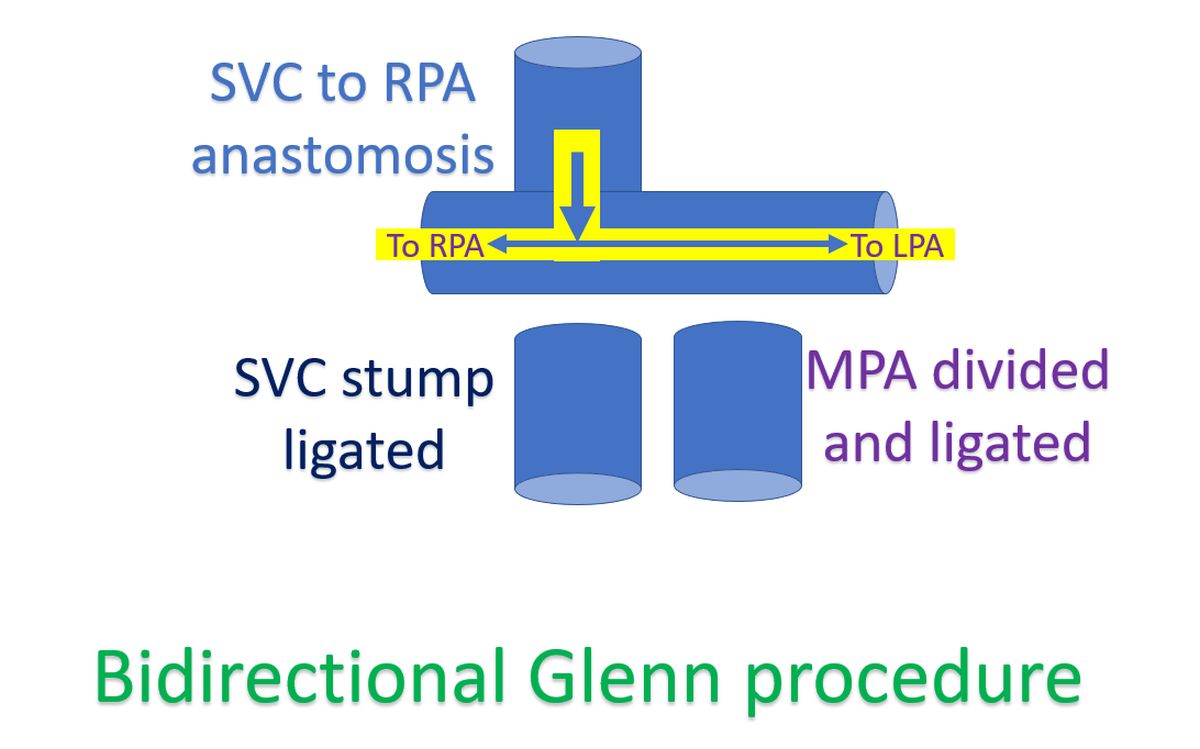What is a bidirectional Glenn procedure (BDG)?
What is a bidirectional Glenn procedure (BDG)?
The classical Glenn procedure is an end to end anastomosis of the superior vena cava to the right pulmonary artery so that the superior vena caval venous blood does not reach the left pulmonary artery. Bidirectional Glenn (BDG) procedure is an end to side anastomosis of superior vena cava to the right pulmonary artery. Main pulmonary artery is then divided and sutured. BDG helps flow into both pulmonary arteries. BDG is performed in patients with anatomical or functional single ventricle, as a palliative procedure. BDG is usually followed later by a Fontan repair.

Bidirectional Glenn procedure improves systemic arterial oxygen saturation without increasing pulmonary vascular resistance. BDG can lead to systemic venous collateral development and pulmonary arteriovenous malformations later. Potential advantages of the bidirectional Glenn procedure are the early elimination of volume overload, avoiding the need for systemic to pulmonary artery shunts and pulmonary artery bands. It also simplifies the operative procedure at the time of future Fontan repair. Some are in favour of leaving an accessory source of pulmonary blood flow like a systemic to pulmonary artery shunt or a patent right ventricular outflow tract at the time of BDG. But there is some data to suggest that morbidity and mortality are lower in patients in whom accessory pulmonary blood flow is eliminated at the time of BDG [1].
A single center retrospective study on early outcomes after on pump BDG published in 2021 had 115 patients [2]. 42.6% of the patients had a double outlet right ventricle. They noted that increased cardiopulmonary bypass times and operative time affected the postoperative outcome. Median postoperative stay in the study was 8 days. Median postoperative oxygen saturation was 82%. Mean age of the patients was 6.55 years (range 9 months to 48 years). Early postoperative complications were noted in 25.2% of patients. Late age of presentation and poor preoperative nutrition increased the risk of postoperative morbidity and mortality.
Another study published in 2020 was on patients less than 3 months of age [3]. Procedures done from 2004 to 2018 at a single institution were studied retrospectively. Primary outcome of the study was Fontan completion and secondary outcomes included mortality, orthotopic heart transplantation and perioperative clinical variables. The median age in the early group was 79 days and 107 days in the nonearly group. 90% of the cavopulmonary anastomoses were augmented with an ePTFE (expanded polytetrafluoroethylene) patch. Overall Fontan completion rate was 76%. There were no operative mortalities and differences in late mortality rate. They concluded that stage 2 palliation at less than 90 days seems to be a viable and safe procedure when indicated. Interstage period is a high risk period for those undergoing single ventricle palliation.
Bidirectional Glenn procedure performed with and without cardiopulmonary bypass were compared in a study of 106 patients operated between 2001 and 2006 [4]. 72 procedures were done under cardiopulmonary bypass and 34 without cardiopulmonary bypass. Median follow up was 30 months. 35.8% of patients had hypoplastic left heart syndrome and 17.9% had tricuspid atresia in this series. Overall mortality was 0.9% and no deaths occurred among the non cardiopulmonary bypass patients. No significant differences in operative mortality, morbidity, or use of resources were noted between the two groups. Long-term survival after the BDG procedure was high with both strategies.
References
- Mainwaring RD, Lamberti JJ, Uzark K, Spicer RL. Bidirectional Glenn. Is accessory pulmonary blood flow good or bad? Circulation. 1995 Nov 1;92(9 Suppl):II294-7. doi: 10.1161/01.cir.92.9.294. PMID: 7586426.
- Naik RB, Srivastava CP, Arsiwala S, Mathur A, Sharma S. Early outcomes after the on pump bidirectional Glenn procedure: A single center experience. J Card Surg. 2021 Sep;36(9):3207-3214. doi: 10.1111/jocs.15719. Epub 2021 Jun 6. PMID: 34091970.
- Viegas M, Diaz-Castrillon CE, Castro-Medina M, Da Fonseca Da Silva L, Morell VO. Bidirectional Glenn Procedure in Patients Less Than 3 Months of Age: A 14-Year Experience. Ann Thorac Surg. 2020 Aug;110(2):622-629. doi: 10.1016/j.athoracsur.2020.03.080. Epub 2020 May 4. PMID: 32380059.
- LaPar DJ, Mery CM, Peeler BB, Kron IL, Gangemi JJ. Short and long-term outcomes for bidirectional glenn procedure performed with and without cardiopulmonary bypass. Ann Thorac Surg. 2012 Jul;94(1):164-70; discussion 170-1. doi: 10.1016/j.athoracsur.2012.03.005. Epub 2012 May 4. PMID: 22560969.



